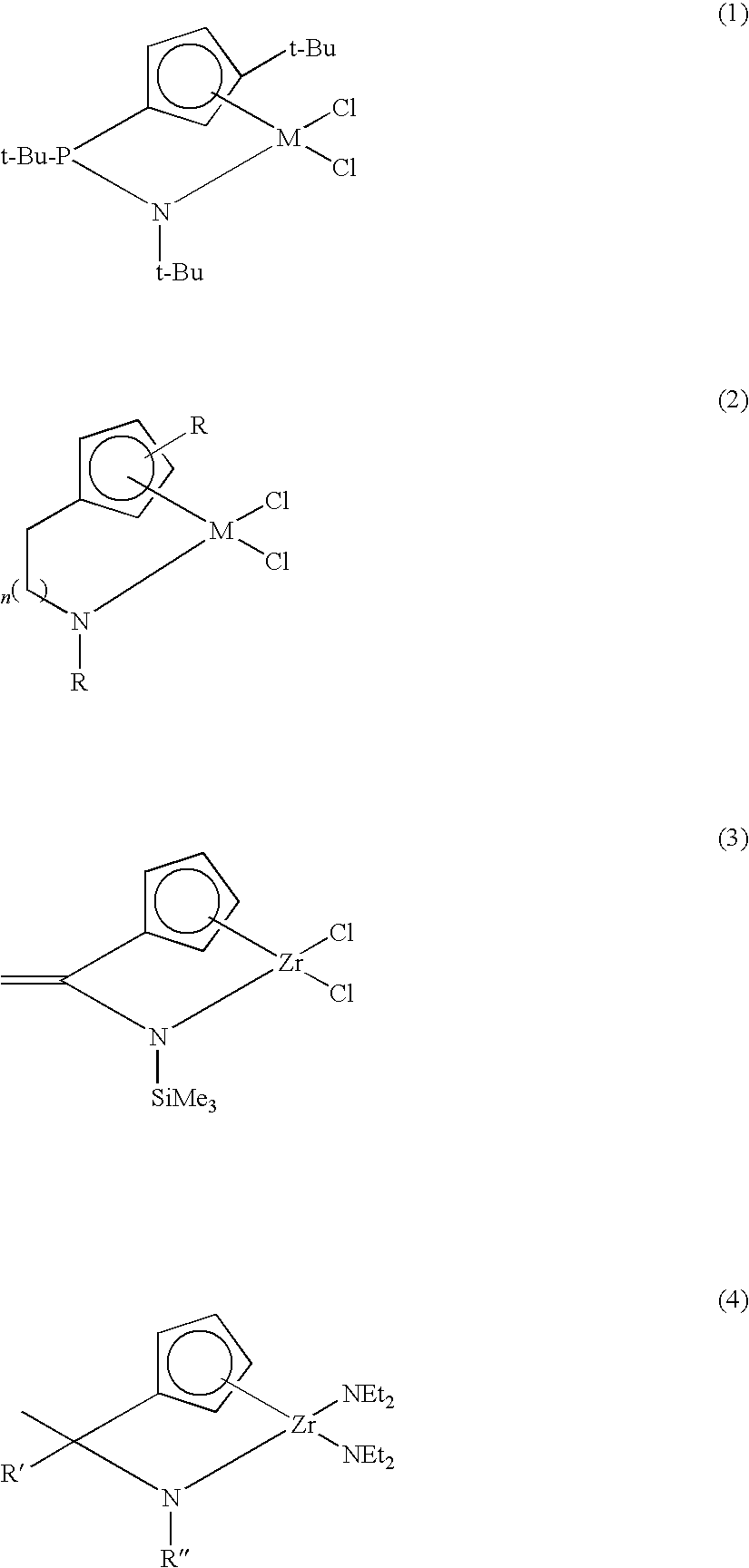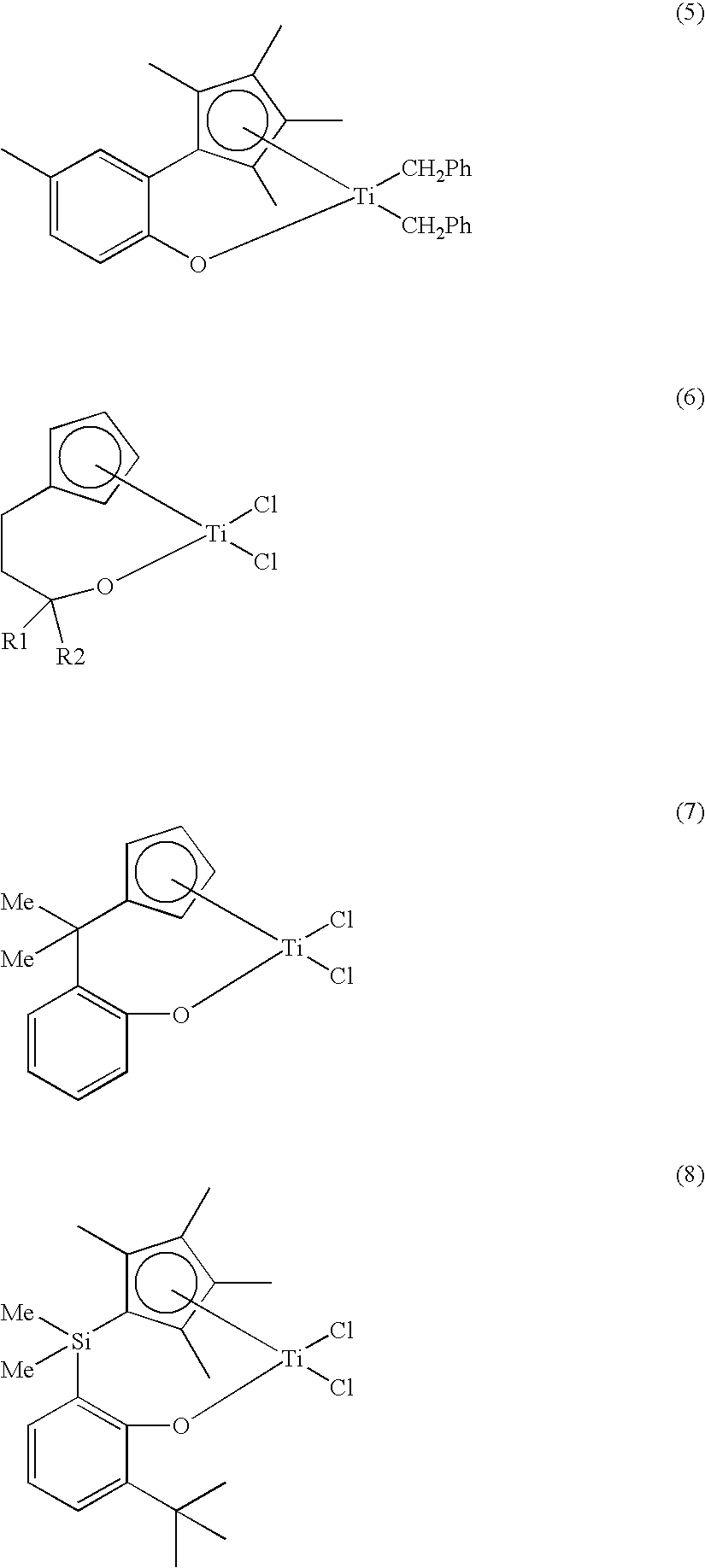Method for preparing transition metal complexes, transition metal complexes prepare using the method, catalyts composition containing the complexes
a technology of transition metal complexes and catalyst compositions, which is applied in the direction of organic compounds/hydrides/coordination complexes catalysts, physical/chemical process catalysts, bulk chemical production, etc., can solve the problems of copolymerization performance and compound activity not showing enhanced activity, and achieve high yield and large steric hindrance. , the effect of preparing a transition metal complex
- Summary
- Abstract
- Description
- Claims
- Application Information
AI Technical Summary
Benefits of technology
Problems solved by technology
Method used
Image
Examples
example 1
Preparation of 8-(2,3,4,5-tetramethyl-1,3-cyclopentadienyl)-1,2,3,4-tetrahydroquinoline (Compound 3a)
[0128]1,2,3,4-tetrahydroquinoline (13.08 g, 98.24 mmol) and diethylether (150 mL) were put into a Schlenk flask. The Schlenk flask was immersed in a dry ice / acetone cooling bath at −78° C., and shaken for 30 minutes. Then, n-BuLi (n-butyl lithium, 39.3 mL, 2.5 M, 98.24 mmol) was introduced thereto using a syringe under nitrogen atmosphere to form a pale yellow slurry. Thereafter, the flask was shaken for 2 hours, and then the flask was warmed to ambient temperature while removing the resulting butane gas. The flask was again immersing into the cooling bath at −78° C., and then a CO2 gas was introduced thereto. As introducing carbon dioxide gas, the slurry gradually disappeared to form a clear solution. The flask was connected into a bubbler to remove the carbon dioxide gas, while raising the temperature to ambient temperature. Thereafter, excess CO2 gas and the solvent were removed u...
example 2
Preparation of [(1,2,3,4-tetrahydroquinolin-8-yl)tetramethylcyclopentadienyl-eta5,kapa-N]titanium dimethyl (Compound 5a)
[0132]In a dry box, the compound 3a (8.07 g, 32.0 mmol) as prepared in Example 1 and diethylether (140 mL) were put into a round flask, and cooled to −30° C. n-BuLi (17.7 g, 2.5 M, 64.0 mmol) was slowly added thereto under stirring. While raising the temperature to ambient temperature, reaction was performed for 6 hours. Thereafter, the mixture was washed with diethylether several times, and filtered to obtain a solid. The remaining solvent was removed under vacuum to obtain a dilithium compound (Compound 4a) (9.83 g) as a yellow solid. The yield was 95%.
[0133]1H NMR (C6D6, C5D5N): δ 2.38 (br s, 2H, quin-CH2), 2.53 (br s, 12H, Cp-CH3), 3.48 (br s, 2H, quin-CH2), 4.19 (br s, 2H, quin-CH2), 6.77 (t, J=6.8 Hz, 2H, quin-CH), 7.28 (br s, 1H, quin-CH), 7.75 (br s, 1H, quin-CH) ppm.
[0134]In a dry box, TiCl4.DME (4.41 g, 15.76 mmol) and diethylether (150 mL) were put into...
example 3
Preparation of 5-indenyl-1,2,3,4-tetrahydroquinoline (Compound 3b)
[0136]The procedure was carried out in the same manner as the preparation method of [Example 1] except that indenone was used instead of tetramethylcyclopentanone, and the resultant was purified by column chromatography using a hexane:ethyl acetate (v / v, 20:1) solvent to obtain a yellow oil. The yield was 49%.
[0137]1H NMR (C6D6): δ 1.58-1.64 (m, 2H, quin-CH2), 2.63 (t, J=6.8 Hz, 2H, quin-CH2), 2.72-2.77 (m, 2H, quin-CH2), 3.17 (d, J=2.4 Hz, 2H, indenyl-CH2), 3.85 (br s, 1H, N—H), 6.35 (t, J=2.0 Hz, 1H, indenyl-CH), 6.76 (t, J=7.6 Hz, 1H, quin-CH), 6.98 (d, J=7.2 Hz, 1H, quin-CH), 7.17 (td, J=1.6, 7.2 Hz, 1H, quin-CH), 7.20 (td, J=1.6, 7.2 Hz, 2H, indenyl-CH), 7.34 (d, J=7.2 Hz, 1H, indenyl-CH), 7.45 (dd, J=1.2, 6.8 Hz, 1H, indenyl-CH) ppm. 13C NMR (C6D6): δ 12.12, 23.08, 27.30, 48.84, 51.01, 119.70, 119.96, 120.95, 126.99, 128.73, 131.67, 136.21 ppm.
PUM
| Property | Measurement | Unit |
|---|---|---|
| Density | aaaaa | aaaaa |
| Temperature | aaaaa | aaaaa |
| Time | aaaaa | aaaaa |
Abstract
Description
Claims
Application Information
 Login to View More
Login to View More - R&D
- Intellectual Property
- Life Sciences
- Materials
- Tech Scout
- Unparalleled Data Quality
- Higher Quality Content
- 60% Fewer Hallucinations
Browse by: Latest US Patents, China's latest patents, Technical Efficacy Thesaurus, Application Domain, Technology Topic, Popular Technical Reports.
© 2025 PatSnap. All rights reserved.Legal|Privacy policy|Modern Slavery Act Transparency Statement|Sitemap|About US| Contact US: help@patsnap.com



